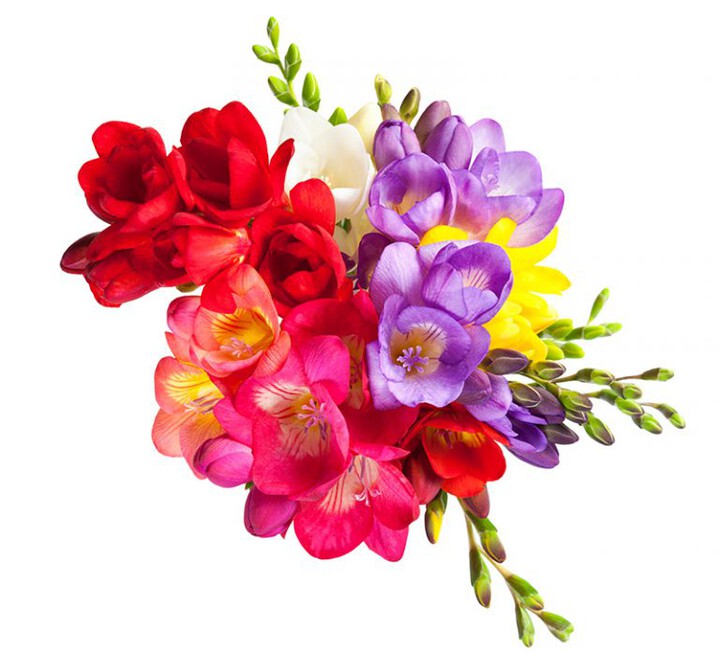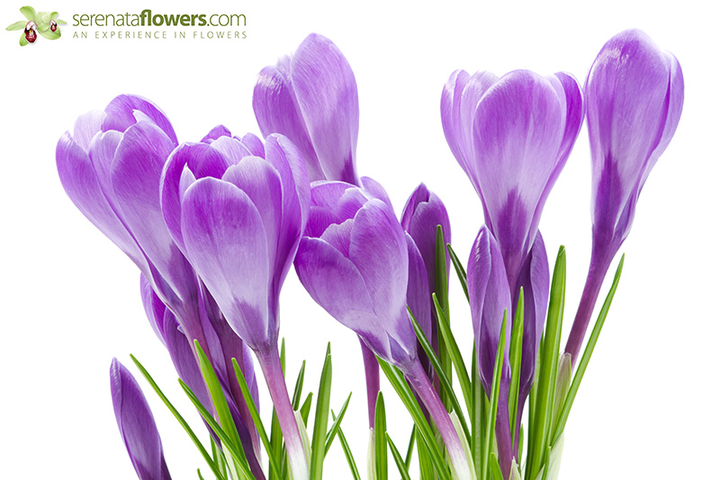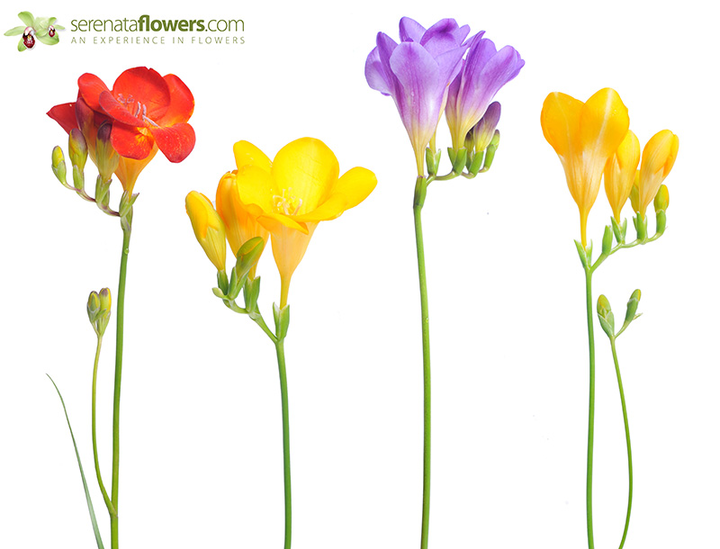
Freesia comes from the Iridaceae family and is a genus of herbaceous perennial flowering plants. It was first named as a genus by Chr. Fr. Echlon in 1866, who named it after the German botanist and doctor, Friedrich Freese.
These plants, with their fragrant funnel-shaped flowers, are native to the eastern side of southern Africa, with the majority of species sourced in the Cape Provinces in South Africa itself.
The plants, which also go by the name ‘freesias’, are cultivated hybrids of a number of Freesia species. Asides from growing in the wild, certain types are solely grown as ornamental plants.
Variations available
There are an impressive 16 different species of Freesia flowers in existence, each one boasting equal measures of beauty and fragrance. These variants include:
·Freesia caryophyllacea
·Freesia andersoniae
·Freesia alba
·Freesia fergusoniae
·Freesia fucata
·Freesia grandiflora
·Freesia viridis
·Freesia laxa
·Freesia corymbosa
·Freesia sparrmannii
·Freesia marginata
·Freesia leichtlinii
·Freesia occidentalis
·Freesia refracta
·Freesia speciosa
·Freesia verrucosa
If you’re looking for pre-prepared combinations of Freesia plants, Serenata Flowers offer an array of options, including baskets and bouquets.
Cultivation and uses
Freesias are the result of a cross between F. refracta and F. leichtlinii. Over the years, a number of cultivars have been bred from these two species, boasting flowers ranging from white to yellow, to pink, red and blue-mauve.
Today, they are mostly cultivated in the Netherlands, with approximately 80 growers in existence.
Due to their pleasing fragrance, Freesias are often used in beauty products such as shampoos and hand creams, as well as in other items including candles and wedding bouquets.
How to plant and grow Freesia at home (indoor vs outdoor)
If you wish to grow ‘garden varieties’ of Freesia, you must be prepared. This involves using freesia bulbs (or corms) that have been exposed to a dormancy-breaking heat treatment.
In effect this means, they have been left in a tropical-like environment, for an average of 12 weeks at a temperature of 30°C. This helps growers to mimic South African conditions.
For best results, pick a spot that boast well-drained soil, in an area that gets sun or light shade. To improve less rich soils, use plenty of organic matter and plant each bulb 5cm into the ground and between 5cm and 8 cm apart.
The bulbs should resemble small, slim onions. It’s important to plant them with the pointed end facing up.
Pre-prepared freesia bulbs can be planted in the autumn months for flowering inside between January and April.
If planting in a greenhouse, they will likely bloom a little earlier and if planted outside, flowers can be expected between the months of April and July.
Once the plants have been established, they will benefit from a potash-rich feed.
Planting in containers
To ensure successful growth, plant six bulbs, pointy end upwards in a container measuring between 10cm and 15cm deep. Use a rich, loam-based compost with a little extra grit to increase drainage. Opt for two thirds compost and one third grit.
Keep the bulbs well-watered and shaded at all times. A cool conservatory or greenhouse is the perfect environment. Once the bulbs begin to sprout, move the pots into an area that receives full sunlight.
When the buds begin to show colour, you can move them indoors. Providing you have used a rich soil or compost, they won’t necessitate feeding.
Aftercare
Freesia will not require feeding, but that is heavily dependent on the soil or compost used. They will usual show their first blooms around 100-120 days after planting.
Irrespective of whether you plant Freesia in the garden or in pots, they will require support to ensure the foliage and flowering stems are kept upright.
When planting in containers, opt for round supports attached to a central cane. When planting in the garden, opt for twiggy end branches made from hazel or silver birch.
Freesias are not fully hardy, which is why you should lift the plants in the months of autumn. The leaves will have usually turned a shade of yellow. Simply cut the stems back to one inch and allow the bulbs to dry. Remove any old portions, allowing only the fresh, plump bulbs to remain.
These can be stored in sand or peat. For best results, it’s important to store them in a dry, cold, frost-free place. Plant again only when the ground begins to warm – this is usually in late April. To extend the flower season, simply stagger plantings.
Freesia season and when to plant Freesia
Freesia plants are usually obtainable during the spring and summer months, although if grown with care and in the correct conditions, they can last well into the autumn months.
In total, there are 16 known species of Freesia available, all of which are native to Africa. Despite this, new variants are now more common to northerly climates, including the likes of the British Isles.
In order to grow Freesia plants successfully, you need to do your research and ensure you give them a lot of care. The best time to plant the seed is generally between the months of September and November.
If planting outdoors, place in an area that gets a lot of sunlight and use well-drained soil. These particular species of plant require water on a weekly basis when in bloom. When they finish flowering, less water is required.

Top tips for planting Freesia
Knowing when to plant the bulbs is the key to success. For best results, plant in the autumn months only if you reside in a warmer region. If you live in a cooler place, plant bulbs in the spring.
If you experience a winter that is harsher than usual, remove the bulbs at the end of the season and store away in a protected environment. Replant them when the weather begins to clear.
How to find good quality Freesia bulbs
Freesia, especially when grown in cooler climates, must be planted from bulbs. It’s therefore extremely important to pick quality bulbs. One easy way to determine a quality bulb is to look at its appearance – for example, don’t choose corms that appear cracked or dried out.
Instead, opt for bulbs that have been prepared by a reputable supplier and are fresh in appearance.
How to deal with Freesia problems
Freesias are a great addition to any outdoor or indoor space. However, like all plants, they can succumb to problems. Common issues include pests such as aphids and slugs, although these are thankfully easy to overcome when armed with the right knowledge.
Freesia plants are pretty hardy and rarely complain, which makes them a great option for those looking to invest in a low-maintenance flower. Every now and again however, they’ll be hit by a common disease or pest. Common freesia plant problems include:
Aphids: These sap-sucking, soft-bodied insects can be the root of twisted, yellowing leaves and flowers. This ailment is easy to treat, providing you’re dedicated to spraying or wiping the plant’s leaves until the aphids have been removed. Another tip involves placing ant baits nearby, at any point when your freesias are plagued with aphids.
Slugs and snails: These land-based mollusks leave chewed leaves and flowers in their wake, which means they can wreak havoc in the garden. It’s a longwinded process, but the best way to rid your garden of these pests is to go out at night with a flashlight and handpick as many as you can find. Alternatively, dunk freesias in a bucket brimming with soapy water.
Bacterial soft rot: This particular ailment is caused by a bacterial infection. It begins in the shape of tiny water-soaked spots, which appear on leaves, blooms and stems. They can then grow and dry out, leaving a black, gray or brown-hued spot behind. In extremely wet conditions, very sick plants may display a brownish bacteria mass.
Unfortunately, once this disease has begun to spread, there is very little you can do. Reducing moisture around plants that are showing mild infections can slow down the development. Normally, it is better to dispose of the infected plants as this will prevent the bacteria from spreading to healthy freesias.
Fusarium wilt: This is one of the most frustrating garden diseases. It’s also incurable once underway. This fungal pathogen lies hidden in the soil, waiting for its chance to contaminate plants.
This ailment usually occurs when conditions are too wet or plants are over fertilised. The leaves will quickly begin to yellow and decline. To prevent this, you’ll need to improve your garden’s drainage in an effort to reduce water levels.
Iris leaf spot: Miniscule, yellow to green water-soaked lesions are usually an early sign of iris leaf spot. These can quickly enlarge to about quarter of an inch. Once the plants have flowered, spots will show more aggressively.
Moving your freesia plants to a better draining area will help to prevent this disease from striking. Additionally, remove all spent leaves at the end of the season. To reduce the number of active spores, remove infected tissue as and when it appears.

How to take care of cut Freesia flowers and style them
Their many hues and alluring floral scent make Freesia flowers hard to resist. They boast a total of eight trumpet-shaped, upward-pointing blooms, all of which sit upon leafless stems. This makes them an ideal option for cut flowers. In addition, they boast a lengthy lifespan.
When cutting Freesia, remove them from your garden early in the morning. At this time of the day, the flowers have benefitted from both the cool night air and morning dew. In addition, they are firm to the touch, as their stems are brimming with carbohydrates and water.
This makes them easier to cut. Cutting flowers when they are dehydrated (midday) will often mean they will appear limp and bent in the vase. For best results, always use clean, sharp scissors to cut freesias, and place the flowers in a vase full of water immediately.
When styling Freesias, you can place them alongside a number of other flower variants. Serenata Flowers offer an array of bouquet options, including Freesias paired with Roses, basket bouquets comprising an array of picture-perfect Memory Lane Roses, colourful Carnations, Chamelaucium and Eryngiums, as well as wreaths brandishing scented Freesia, white Roses and an assortment of Chrysanthemums.
Classic decorated wreath with white Roses, scented Freesia, Chrysanthemum and Eryngium. This wreath measures approximately 38 cm in diameter. Memory Lane Roses, Carnations, Freesia, Eryngium and Chamelaucium
Meaning of Freesia flowers and symbolism
With their sinewy stems and subtle blooms, it’s no surprise that one of the most prevalent Freesia varieties is named the Ballerina.
In the language of flowers, Freesias are said to be symbolic of friendship, thoughtfulness, trust, sweetness and innocence, which is one of the reasons they’re often gifted to those celebrating their seventh wedding anniversary.
In fact, Freesias are popular wedding flowers across the globe. This is mainly due to their delicate blooms, which add both hue and fragrance to any floral display. Asides from bridal bouquets, they’re also popular as table centerpieces.
Interesting facts
·The genus freesia contains 16 recognised species of flowers, all of which belong to the Iris family. All in all, it’s estimated there are an impressive 1,800 types of freesia in existence, which range in hue from white to ivory to yellow, with the addition of an array of pink, purple and red shades. These delicate blooms sit upon a 12- to 18-inch scape, otherwise known as a stem.
·Being native to South Africa, these blooms prefer a tropical environment, which is one of the reasons they are grown as a cut flower in cooler parts of the world.
·They boast a vase life of between seven and ten days.
·They first gained their popularity in 1950s, and since then have been used for wedding bouquets and special occasions.
· Unlike most species of flower, where white flowers tend to be the most fragrant, pink and red freesia flowers boast a stronger scent.